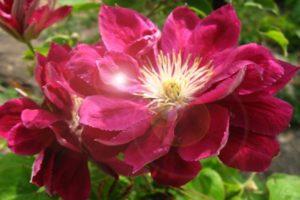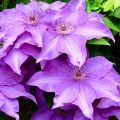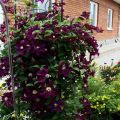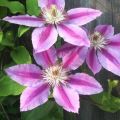Description and characteristics of clematis varieties Kaiser, planting and care
Russian flower growers have recently learned about Clematis Kaiser. This variety of shrubby liana originated in Japan. It has been grown in its homeland since 1997. It appeared in Europe and Russia after 2010. The variety blooms from May to October, for this it is loved by amateur gardeners and professional designers.
Description and characteristics of Clematis Kaiser
Kaiser is a climbing perennial plant with long, flexible shoots. The length of the central stem is 1.5-2 m. From it there are many lateral branches covered with large dark green leaves. The edge of the sheet plates is carved. When the temperature drops, the leaves turn pale. The perennial has an average level of frost resistance, in the Middle Lane, it does not freeze out. Liana has been growing in one place for 25 years.

Flowering features
The Kaiser variety is unique. It has 2 peaks of flowering. First, the buds are strewn with the bush in May, they are formed on the overwintered shoots of the last year. The second wave occurs in July and lasts until frost.
The flowers are striking in their beauty and delicate aroma. They are large, terry. The diameter of the largest specimens is 14 cm. Multilayer baskets consist of petals of several shades:
- pink;
- purple;
- scarlet;
- lilac.
The flower has a yellow core. When the temperature drops, the color of the petals lightens, white specks appear on them. Flower buds are laid on 1-2-year-old shoots.
Which trim group belongs to
The Kaiser variety is included in the 2nd pruning group. This type of vines is gaining decorativeness over time. The first years of flowers are few. Shoots that have grown over the summer are not cut off for the winter, so there are difficulties with wintering.

Advantages and disadvantages
Clematis Kaiser is appreciated for its unusually beautiful flowers and long flowering. The disadvantages of the variety include:
- crown formation work;
- average winter hardiness;
- frequent garter of side branches.
How to grow flowers correctly
The variety is bred for warm climates. In Russia, it is grown in the Central lane. In Siberia and the Urals, he does not winter. Caring for the Kaiser is not easy.
Florists spend a lot of time on pruning, garters, and preparing for winter.

Sapling selection
Be sure to assess the condition of the root system. It is good if it has 3 roots 10-15 cm long. It is bad if they have thickenings, swellings. The requirements for the aboveground part of the planting material depend on the season:
- for planting in autumn, seedlings with formed vegetative buds are needed;
- if planted in spring, there should be a shoot.
When the roots of a seedling are poorly developed, it is grown in a "school".
Place and dates
For clematis Kaiser, areas where groundwater occurs at a depth of 1-1.2 m are not suitable. It will not bloom profusely in partial shade or shade. Liana needs at least 5 hours of direct sunlight. This requirement is met by plots located in the south, southeast, southwest of the garden. The absence of drafts is another prerequisite.

| Landing region | Planting time of Clematis Kaiser | |
| Spring | Fall | |
| South of Russia | March | September-November |
| Middle lane | April (end of month), May | September |
Soil composition
Perennial vine does not like acidic soils. Clematis Kaiser grows well on loams fertilized with humus, with a neutral and alkaline reaction. Florists normalize the pH level, add deoxidizers for digging:
- lime fluff;
- gypsum;
- dolomite flour.
Landing technology
Clematis Kaiser is planted for a long time, therefore, the planting pit is thoroughly prepared. With a single planting, it is dug 0.6 * 0.6 * 0.6 m in size, planting several vines, dug up the entire area. The roots of the seedlings are covered with garden soil, mixed with humus, fertilizers.

| Fertilizer | amount |
| Peat | 1 bucket |
| Sand | 1 bucket |
| Humus | 2 buckets |
| a piece of chalk | 150 g |
| Fertilizer for clematis | 200 g |
| Bone flour | 100 g |
| Superphosphate | 150 g |
| Ash | 200 g |
Drainage is laid first. It is poured with a layer of 15-20 cm. Then part of the soil mixture is poured. A mound is formed from it in the center. The seedling is placed on this elevation, holding it with your hand, the roots are covered. To form the center of tillering, the cutting is deepened by 8-12 cm.
When planting in spring, a hole is formed around the seedling. Fall asleep it when the shoots become woody. The liana is watered, the trunk circle is mulched. When planting in autumn, the hole is completely covered with earth, the shoots are cut off.
Support and garter clematis
In clematis of the 2nd group of pruning in the fall, the whips (summer growth) are lowered to the ground, not cut off. The support structure is constructed with this feature in mind. Twine, ropes or a special plastic net are fixed on it.
In the spring, last year's shoots are attached to them, in the summer they tie up a young growth. It grows back quickly, so young branches are attached to the support every 3 days.

Care rules
After transplanting, young plants are covered from bright sunlight. The trunk circle is covered with mulch. A layer of humus (peat) with a thickness of 5-7 cm protects the roots from overheating, the top layer of the soil from rapid drying and crust formation. Throughout the season, weeds are removed around clematis, the aisles are loosened. In rainy weather, excess moisture is removed from the root zone.
Watering and feeding
A perennial vine is watered not often, but a lot. Water is poured so that drops do not fall into the central part of the bush. Clematis Kaiser is fed 3-4 times per season:
- fertilizer for clematis, 40 g of the drug is dissolved in a bucket;
- mullein solution, 10 parts of water are taken for 1 part of mullein;
- 2 g of boric acid and potassium permanganate are dissolved in a bucket of water.
In summer, clematis Kaiser bushes are sprayed with a urea solution. A liquid fertilizer of low concentration is prepared. In 10 liters of water dissolve 0.5 tbsp. l. granules.

Pruning
Shoots that have grown over the summer do not need to be cut. They will have flowers next summer. In autumn, they are shortened, leaving 10-15 knots. Then each lash is folded into a ring, laid on the ground. All last year's shoots are cut out.
In the spring, they find and cut out all branches damaged during the winter. Healthy 2-year-old lashes are shortened. In summer, control the density of the bush. Some of the side shoots are removed to provide the vines with good lighting and ventilation.
Wintering
In the south, Kaiser clematis winters without shelter. In the middle lane, it is grown as a covering crop.So that growth buds do not suffer from dampness, an air-dry shelter is built over the lashes laid on the ground.
The structure consists of a frame and a covering material stretched over it. Clematis bushes are closed for the winter after the onset of the first frost. The work is carried out on a clear, sunny day:
- they spud the bush, mulch the trunk circle with a mixture of sand and ash;
- shoots are freed from leaves, folded, laid on the ground, agrospan is placed on top;
- a frame for the covering material is installed from shields, boxes, boards;
- throw on a PVC film;
- with the arrival of winter, they cover the shelter with snow, spruce branches, and reed mats.

Diseases and pests
Clematis Kaiser is sprayed with insecticide if pests are found on the leaves. He can suffer from aphids, spider mites, snails, slugs, nematodes. Insects carry a fungal infection that affects the leaves and the root system. Simple measures help protect clematis from rot:
- competent watering scheme;
- timely thinning of the crown;
- top dressing;
- treatment of the bush with fungicides (Fundazol), insecticides.
Bushes infected with nematodes are destroyed. The soil where they grew is treated with drugs (nematacides).
Reproduction
Choose a strong lateral shoot. They put it in the furrow, pin it with staples, sprinkle it with a mixture of garden soil, sand and peat. A year later, the rooted shoots are cut off from the mother bush, transplanted.
Once every 6-7 years, the Kaiser clematis bushes rejuvenate. The perennial root is dug out, divided into several parts, leaving 1-2 basal buds on each. During budding, cuttings are cut from the middle part of the cut shoots.
Cuttings are rooted in the substrate. To speed up the formation of roots, create greenhouse conditions:
- air temperature 18-22 ° C;
- air humidity 90%.
In autumn, Clematis Kaiser is propagated by lignified cuttings. They are rooted in boxes. They are transplanted to the school in the spring.

Examples in landscape design
Liana is planted next to beautiful garden structures: arches, pergolas, screens, trellises. To make it easier for the shoots to braid the support, it is covered with a net or lattice. Low annuals and perennial ornamental plants are planted next to Kaiser clematis:
- irises;
- chamomile;
- phlox.

Kaiser is grown on loggias, balconies, terraces. Clematis seedlings are planted in wide pots of large volume (height 40 cm), 1.5-meter supports are installed. Clematis Kaiser is ideal for vertical landscaping.









